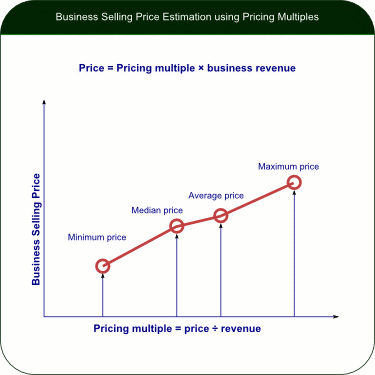Business Valuation Guide
Estimating Business Market Value
Do you need to determine what the business is worth on the market?
Is your business appraisal backed by solid market proof?
Are you selling your business or planning to buy one?
Do you know what similar private businesses sell for?
Do you know how successful deals are structured?
Or how long it takes to sell a business like yours?
To answer these key questions, consider using the Comparative Transaction Method under the market approach. This well-known business valuation method gives you a detailed picture of your business value in comparison to the sales of similar private businesses.
Valuation Multiples • Business Selling Prices • Acquisition Deal Terms
You can come up with an accurate, defensible calculation of your business value: starting with the business sale comps, deriving a number of valuation multiples, and determining the fair market value of your company based on the business’ key financial performance factors.

How you can use this business market value estimation:
- Determine your business’ fair market value with valuation multiples based on business revenue, cash flow, profits, and assets.
- Set a compelling offer or asking price for a business you plan to buy or sell.
- Define your deal terms including down payment, seller and bank financing, non-compete and employment agreements, earnouts.
- See how long it takes to sell a business in your industry.
- Defend your business valuation by referring to the comparable business sales data.
- Gather business sales comps.
- Calculate valuation multiples from them.
- Estimate your business fair market value!
Private business sales occur across all industries – including yours
To get reliable data, focus on comparable business sales that are reported by business brokers or filed by a public firm acquiring a private company.
Next, locate comparable business sales that match your business. Carefully analyze the sales data to get a comprehensive assessment of your business market value, and critical business pricing and deal structuring information.
There are comparable business sales that represent private company and professional practice transfers for all types of industries, usually classified by unique SIC codes. Here is the sampling of the major industries that show a high volume of business sales each year:
- Personal and professional service firms
- Professional practices
- Restaurant industry
- Automotive services
- Retail businesses
- Health care and social services
- Wholesale trade
- Manufacturing firms
- Construction industry
- Real estate and financial services
- Internet and technology firms
- And many more
Market data on private business sales
Make sure that your Business Market Value Estimate relies on the current private business sales, whether compiled by professional business analysts or reported by the public companies directly.
This gives you the confidence needed to make direct market comparisons to determine the value of your firm.
Fact-based business market value estimation
The effort is well worth it: you will know all there is to know about the business market value and selling prices. Now you can develop a number of compelling business selling price indicators to estimate your business worth, including:
- Revenues and earnings of sold businesses and professional practices.
- Actual business selling price ranges and averages.
- Ratios of selling to asking prices.
- Days on market.
- Inventory, total business assets and FF&E.
- Pricing multiples to estimate your business market value.
How to price a business: pricing multiples
The pricing multiples are statistically derived factors that relate the business financial performance to its potential selling price:
- Price divided by business revenue.
- Price divided by seller’s discretionary cash flow.
- Price divided by business net income.
- Price divided by EBITDA, EBIT, EBT, or gross margin.
- Price divided by business assets.
- Price divided by owners equity.
For example, to estimate the business selling price you can take its revenue and multiply it by the business selling price to revenue pricing multiple.
How to use the multiples for business price estimation
You can easily estimate your business selling price by using these multiples. This graph shows how to use the selling price to business revenue multiples to estimate the likely selling price range, the average and median selling prices:

